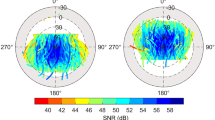Abstract
The growing technological needs for multi-instrument datasets require proper understanding of the behaviour of the datasets relative to each other. This paper presents the first results of analysis on the relationship between in-situ ground refractivity measurements and Constellation Observing System for Meteorology, Ionosphere, and Climate (COSMIC) refractivity measurements in the African equatorial region. In-situ measurements of surface refractivity obtained from four atmospheric ground stations in the region are compared with COSMIC-1 refractivity measurements at 1 km altitude. The in-situ datasets cover the periods from years 2007 to 2014, and corresponding COSMIC-1 datasets over the same period was used. Datasets from the recently launched COSMIC-2 mission (October 2019–September 2020) were utilized to show that the typical differences between refractivity values measured at 0 and 1 km altitudes are about 48 N-units. Interestingly, time-coincident measurements from COSMIC-1 (at 1 km altitude) and from ground in-situ measurements indicate that there is a similar typical difference (about 52 N-units) between refractivity values at the two altitudes. The reason for using COSMIC-2 measurements is that the altitudes covered by COSMIC-1 measurements start from a minimum of 0.1 km, and even at this altitude, the COSMIC-1 measurements are very scanty that there are no coincident observations with the in-situ ground stations. This is why it became imperative to first use COSMIC-2 measurements which cover altitudes from as low as 0 km. The reason is to validate that the difference between COSMIC measurements at 0 and 1 km altitudes are equivalent/comparable to difference between in-situ ground measurements and COSMIC measurements at 1 km. These results indicate that the COSMIC measurements at 0 km are comparable to the in-situ ground measurements.






Similar content being viewed by others
Data availability
The datasets generated during and/or analysed during the current study are available from the corresponding author on reasonable request.
References
Abimbola O, Bada E, Falaiye A, Sukam Y, Muhammad S (2020) Estimation of radio refractivity from a decade satellite derived meteorological data for West Africa. https://arxiv.org/pdf/2012.00245.pdf.
Adediji A, Ajewole M (2008) Vertical profile of radio refractivity gradient in Akure, south-west Nigeria. Prog Electromagn Res C 4:157–168
Adediji A, Ismail M, Mandeep J (2014) Performance analysis of microwave radio refractivity on radio field strength and radio horizon distance over Akure, Nigeria. Wirel Pers Commun 79:1893–1909. https://doi.org/10.1007/s11277-014-1963-0
Agbo G, Onuorah L, Okoh D (2020a) Contribution of some meteorological parameters in the variation of tropospheric radio refractivity in Yola Nigeria. EBSU Sci J 1(1):157–162
Agbo G, Onuorah L, Okoh D (2020b) Daily and seasonal variations of tropospheric radio refractivity at Akure in South-West Nigeria using Campbell scientific automatic weather instrument. Int Res J Innov Eng Technol 4(2):1–7
Ayantunji BG, Okeke PN, Urama JO (2011) Seasonal variation of surface refractivity over Nigeria. Adv Space Res 48(12):2023–2027
Bawa M, Galadanci G, Ayantunji B, Mai-Unguwa H, Muhammad M, Ibrahim U (2017) Variation of meteological parameters and its effect on refractivity index of air over Lagos Nigeria, Bayero. J Pure Appl Sci 10(2):222–225
Bevis M, Businger S, Chiswell S et al (1994) GPS meteorology: mapping wet delays onto precipitable water. J Appl Meteorol 33:379–386
Fashade O, Omotosho T, Akinwumi S, Olorunyomi K (2019) Refractivity gradient of the first 1 km of the troposphere for some selected stations in six geo-political zones in Nigeria. IOP Conf Ser Mater Sci Eng. https://doi.org/10.1088/1757-899X/640/1/012087
Nzeagwu J, Okoh D, Urama J, Chukwude A (2020) MATLAB program to extract atmospheric parameters from COSMIC wetPrf and wetPf2 NetCDF files (Version 1.0). Zenodo. https://doi.org/10.5281/zenodo.4405265
Nzeagwu J, Urama J, Chukwude A, Okoh D (2021) A study on the impact of GPS-derived tropospheric delay over some Nigerian stations. Res Rev J Space Sci Technol 10(1):10–21p
Olasoji Y (2016) Effect of atmospheric refraction on wave propagation with variations based on geographical location in tropical environment. Int J Innov Eng Technol 7(1):37–40
Smith E, Weintraub S (1953) The constants in the equation for atmospheric refractive index at radio frequencies. Proc Inst Radio Eng 41:1035–1037
Xie F, Wu C, Ao E, Kursinski A, Mannucci SS (2010) Super refraction effects on GPS radio occultation refractivity in marine boundary layers. Geophys Res Lett 37:L11805. https://doi.org/10.1029/2010GL043299
Yusuf N, Ekpe O, Rabia S, Ayantunji B, Umahi A (2019) Seasonal and diurnal trends of surface refractivity in a tropical environment using ground based automatic weather stations. Meteorol Atmos Phys. https://doi.org/10.1007/s00703-019-00693-6
Acknowledgements
The results presented in this paper rely on TRODAN data collected and managed by the Centre for Atmospheric Research, National Space Research and Development Agency, Federal Ministry of Science and Technology, Anyigba, Nigeria. We thank the Centre for Atmospheric Research and their partners for promoting high standards of atmospheric observatory practice as well as the Federal Government of Nigeria for continuous funding of the Nigerian Space programme (http://www.carnasrda.com). We also appreciate the University Corporation for Atmospheric Research (UCAR) and the COSMIC team for making COSMIC GNSS radio occultation data used in this work available at the website (https://data.cosmic.ucar.edu/).
Author information
Authors and Affiliations
Corresponding author
Additional information
Responsible Editor: Xinxin Xie.
Publisher's Note
Springer Nature remains neutral with regard to jurisdictional claims in published maps and institutional affiliations.
Rights and permissions
About this article
Cite this article
Nzeagwu, J.N., Urama, J.O., Chukwude, A.E. et al. Comparative assessment of radio occultation-based refractivity measurements from the COSMIC mission and in-situ atmospheric measurements in equatorial Africa. Meteorol Atmos Phys 133, 1545–1554 (2021). https://doi.org/10.1007/s00703-021-00827-9
Received:
Accepted:
Published:
Issue Date:
DOI: https://doi.org/10.1007/s00703-021-00827-9




